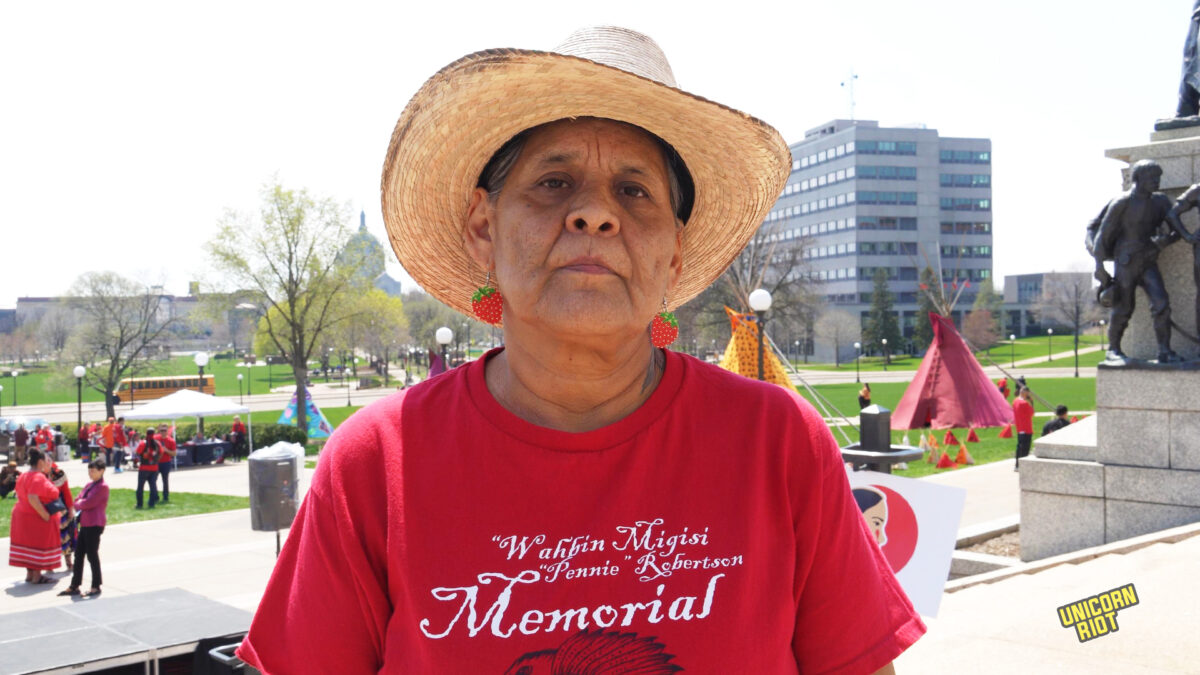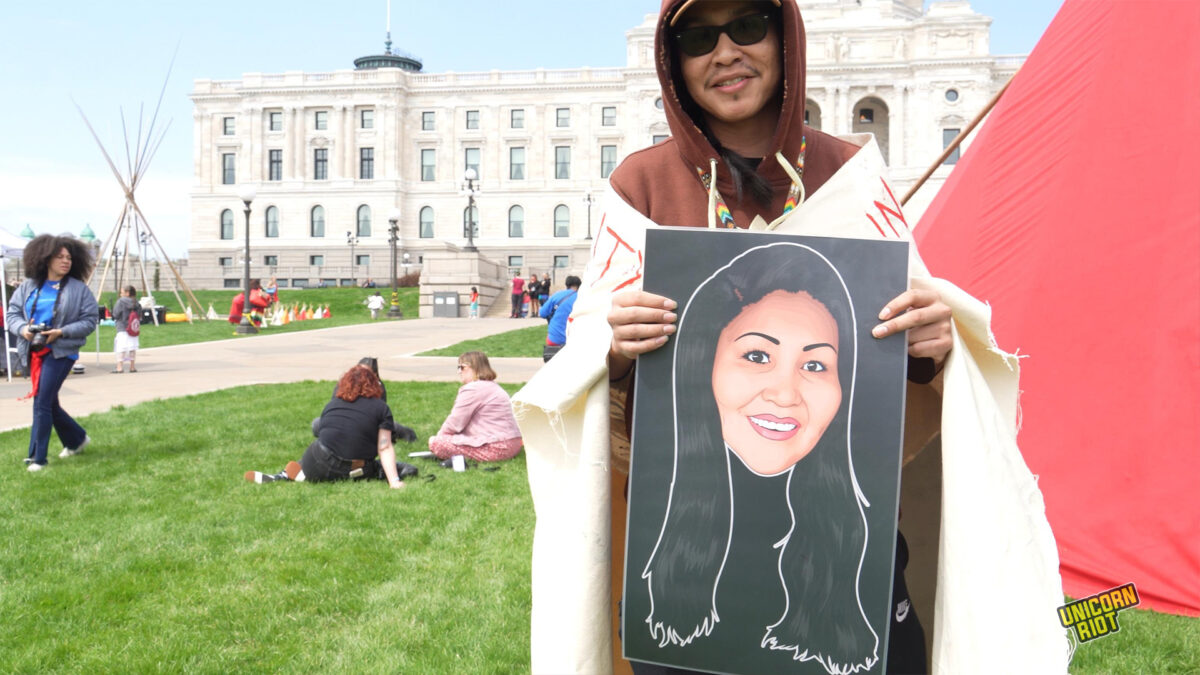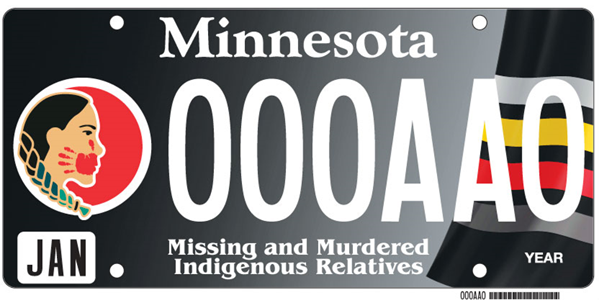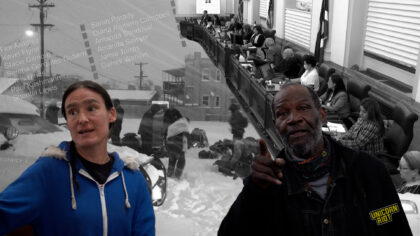Murdered and Missing Indigenous Women and Relatives Remembered
Minneapolis, MN — On any given month in the past decade, a range of 27 to 54 Indigenous women and girls are listed as missing in Minnesota. To raise awareness of this crisis of missing and murdered Indigenous women, two-spirit people and relatives (MMIW/R), activists in Minnesota use Valentine’s Day, February 14, to hold events, along with May 5 being the official MMIW day.
Annual art builds, marches and ceremonies occur in various cities and reservations across Minnesota that are attended by supporters, activists, community leaders, elected officials, and families with missing and/or murdered relatives. At the Minnesota Indian Women’s Resource Center in South Minneapolis on February 13, Unicorn Riot heard from artists, activists and community leaders and covered the MMIW march featuring hundreds of people the next day, see video below.
“This day was really started, and we continue to hold it, to make sure we raise awareness, to make sure that people pay attention, to make sure that our stories are heard in the media … we hear a lot of stories about missing and murdered people, but they’re not often Black and brown people, so we want to make sure that our stories get out there, that our people’s faces get out there.”
Nicole Matthews, founding executive director of Minnesota Indian Women’s Sexual Assault Coalition (MIWSAC)
The reality of missing and murdered Indigenous women and relatives is as old as European settlers manifesting a genocidal destiny in North America and later founding the United States. Over 56 million Indigenous people on the continent were killed by European settlers in just the 1500s and at least 12 million Indigenous people were killed in what’s now the U.S. from 1492 to 1900.
Centuries later, settler-colonial violence continues to take root in different forms including state-run child welfare and criminal justice systems, continuation of boarding schools, human trafficking, man camps near reservations, substance abuse, poverty and houselessness.
In Minnesota, eight percent of all murdered women and girls are Indigenous despite only making up one percent of the population, according to a 2023 Wilder Research report “Missing and Murdered Indigenous Relatives.”
After creating an MMIW Task Force in 2019, the State of Minnesota formed the Missing and Murdered Indigenous Relatives (MMIR) Office two years later with a vision to “reduce and end violence against all Indigenous people in Minnesota.” To do this, they work on “the development and implementation of systemic legislative and transformative social justice policies paired with the application of sufficient resources, programs, and services that will foster safety, equity, healing, civil and human rights of Indigenous peoples and communities in Minnesota.”
The MMIR Office worked with Wilder on the 2023 report and with it released a report roadmap detailing themes, issues and “emerging best practices” in MMIW cases.
Within the Wilder Research report, one of the listed current issues in the state is how community members may be delayed in filing missing person reports “due to lack of trust in law enforcement.”
“Law enforcement played a significant role in enforcing settler colonialist laws, including confining Indigenous communities to reservation boundaries and prohibiting cultural practices,” reads the report.
“This history of law enforcement maltreatment, paired with ongoing discrimination and disproportionate rates of arrest, use of deadly force, and incarceration among American Indian communities, may contribute to distrust of law enforcement among Indigenous communities.”
Wilder Research report
Read the full 156-page report below.
Families of loved ones who’ve gone missing or have been murdered consistently point to police bias toward Indigenous people and mistrust of the police as main reasons for the failed investigations.
After going missing in Minneapolis during a cold November night in 2022, the family of 20-year-old Alexis White Hawk-Ruiz expressed that they didn’t trust the Minneapolis Police to properly investigate her disappearance.
Family members of Alexis White Hawk-Ruiz, her friends, activists, and supporters held regular search parties and investigated the case themselves. She was found deceased over four months later.
In 2019, 31-year-old mother of five, Wabinmigisi Pennie Robertson, went missing in northern Minnesota on the Fond du Lac reservation. After no assistance from law enforcement, her family found her deceased body.
On May 5, 2023, at the Minnesota State Capitol in Saint Paul, Pennie’s mother Lauren Matrious, said to Unicorn Riot, “Seven days later, we found her. Her siblings found her. We had no help from any jurisdiction or tribal. We had no help from law enforcement.”

“MMIW is an epidemic that our Indigenous women and two-spirit relatives face. But we’re also facing epidemic of invisibility,” said Warlance Miner, an enrolled member of the Cheyenne River Sioux Tribe. Miner said their mother Mary Kate Fast Horse was found dead in Seattle, Washington in 2021. Washington state has the second highest MMIW count in the nation and has also created a MMIW/P Task Force.
Fast Horse had been missing for several weeks, said Miner, before finding out she was dead on May 3, two days before MMIW day and a week before Mother’s Day — making the beginning of May an exceptionally hard month. Fast Horse’s cause of death was ruled as “accidental overdose” and Miner said the family questions the authority’s ruling.
During this year’s art build, Nicole Matthews, the executive director of Minnesota Indian Women’s Sexual Assault Coalition (MIWSAC), said, “There’s a lot of stories and we have a lot of relatives that have been missing for a number of years … and many more that we don’t know of or that aren’t publicized.”
The lack of publication and media reporting on MMIR cases compared to that of white cases is mentioned in the state’s report roadmap. The state’s MMIR Office recommends that media change their approach to reporting on MMIR cases and that they “adopt a survivor-centered approach to create a positive character profile of victims.”
Along with going missing and murdered, Miner said they feel like Indigenous people are “also facing an epidemic of invisibility.“
“The biggest set of advice I can offer is, listen when Indigenous and Native people speak up.”
Warlance Miner

Aside from investigating the current cases and preventing future ones, “there is a need for healing,” said Miner.
The many events on the multiple annual days allow for opportunities for impacted families and others to gather, create community and work toward healing.
Jase Roe, a two-spirit community activist and Indigenous influencer, called the art build in South Minneapolis a “healing event” and said they’ve been coming for the last four years. There’s “hugging” and “laughter and there’s unity and there’s community building … and we help heal each other,” said Roe.
“I feel like it’s important for Natives to support other Natives really, at the end of the day, because being Native is an experience in itself, and if you’re not Native, you don’t know the experience. So it’s important that we support and uplift each other because we have so much trauma and we carry so much hurt and pain that we can understand each other. And when we come together there’s laughter. You hear laughter, and that’s healing. If whenever you get a group of Natives together, you’re going to hear laughter. And I think that’s a beautiful thing.”
Jase Roe
This year on February 14, the State of Minnesota unveiled a special MMIR license plate. Incorporating the sacred colors of the four directions — red, white, yellow, and black — the state says the plate features a red handprint symbolizing “the historic silencing of the violence that Indigenous people have faced for generations and the dedication to hearing those voices moving forward” and aims to bring lasting recognition to missing and murdered Indigenous relatives.

The MMIR Office has listed resources for what to do when a child goes missing, some of which are seen below in the resource brochure.
Cover image featuring 2024 events created by Akičita Šuŋka-Wakaŋ Ska for Unicorn Riot.
Ongoing Coverage around Murdered and Missing Indigenous Women and Relatives:
- Missing Minneapolis Indigenous Woman, Alexis White Hawk-Ruiz, Has Been Found Deceased (April 12, 2023)
- Family Hosts Press Conference/Vigil to Find Alexis Whitehawk-Ruiz (December 21, 2022)
- Ricky Balsimo Remembered a Year After Being Found Dismembered at the Bottom of Lake Superior (Aug. 28, 2022)
- Slain Oglala Lakota Woman’s Convicted Murderer Granted Parole, Release Delayed (Dec. 9, 2020)
- Former Probation Officer Convicted of Double Murder Commuted by California Gov., Granted Parole (Oct. 30, 2020)
- A Walkthrough of “Bring Her Home: Stolen Daughters of Turtle Island” (May 6, 2019)
- Missing and Murdered Indigenous Women’s Task Force Inches Closer to Reality (Mar. 6, 2019)
- Three MMIW events in Minneapolis Demand Justice (Mar. 03, 2019)
- Minneapolis Gathers to Honor Missing & Murdered Indigenous People (Oct. 18, 2018)
- Camp Healing Souls Joins Solidarity Actions to #AbolishICE (Jul. 23, 2018)
- March Raises Alarm for Missing and Murdered Indigenous Women (Apr. 10, 2018)
- Hundreds March to Raise Awareness of Murdered Missing Indigenous Women (Feb. 15, 2018)
- “No More Stolen Sisters” Demonstration Blockades DAPL Man Camp; 25+ Arrests (Nov. 16, 2016)
- Deprogram: Episode 23 (Oct. 7, 2015)
Follow us on X (aka Twitter), Facebook, YouTube, Vimeo, Instagram, Mastodon, Threads, BlueSky and Patreon.
Please consider a tax-deductible donation to help sustain our horizontally-organized, non-profit media organization:



